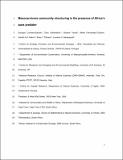Files in this item
Mesocarnivore community structuring in the presence of Africa's apex predator
Item metadata
| dc.contributor.author | Curveira-Santos, Gonçalo | |
| dc.contributor.author | Sutherland, Chris | |
| dc.contributor.author | Tenan, Simone | |
| dc.contributor.author | Fernández-Chacón, Albert | |
| dc.contributor.author | Mann, Gareth K. H. | |
| dc.contributor.author | Pitman, Ross T. | |
| dc.contributor.author | Swanepoel, Lourens H. | |
| dc.date.accessioned | 2021-11-03T13:30:01Z | |
| dc.date.available | 2021-11-03T13:30:01Z | |
| dc.date.issued | 2021-03-10 | |
| dc.identifier | 273499885 | |
| dc.identifier | 1d655755-ab97-474f-9cdd-7edbbef15ce8 | |
| dc.identifier | 85102915252 | |
| dc.identifier | 000627840400006 | |
| dc.identifier.citation | Curveira-Santos , G , Sutherland , C , Tenan , S , Fernández-Chacón , A , Mann , G K H , Pitman , R T & Swanepoel , L H 2021 , ' Mesocarnivore community structuring in the presence of Africa's apex predator ' , Proceedings of the Royal Society B: Biological Sciences , vol. 288 , no. 1946 , 20202379 . https://doi.org/10.1098/rspb.2020.2379 | en |
| dc.identifier.issn | 0962-8452 | |
| dc.identifier.other | Jisc: 2a261923ff4c423e9ea50168744627ed | |
| dc.identifier.other | ORCID: /0000-0003-2073-1751/work/91341078 | |
| dc.identifier.uri | https://hdl.handle.net/10023/24250 | |
| dc.description | This work was supported by the Peace Parks Foundation; G.C.S. was funded by a doctoral grant from Fundacão para a Ciência e a Tecnologia (FCT: PD/BD/114037/2015); L.H.S. was supported by the National Research Foundation, South Africa (UID: 107099 and 115040) and by the African Institute for Conservation Ecology. | en |
| dc.description.abstract | Apex predator reintroductions have proliferated across southern Africa, yet their ecological effects and proposed umbrella benefits of associated management lack empirical evaluations. Despite a rich theory on top-down ecosystem regulation via mesopredator suppression, a knowledge gap exists relating to the influence of lions (Panthera leo) over Africa's diverse mesocarnivore (less than 20 kg) communities. We investigate how geographical variation in mesocarnivore community richness and occupancy across South African reserves is associated with the presence of lions. An interesting duality emerged: lion reserves held more mesocarnivore-rich communities, yet mesocarnivore occupancy rates and evenness-weighted diversity were lower in the presence of lions. Human population density in the reserve surroundings had a similarly ubiquitous negative effect on mesocarnivore occupancy. The positive association between species richness and lion presence corroborated the umbrella species concept but translated into small differences in community size. Distributional contractions of mesocarnivore species within lion reserves, and potentially corresponding numerical reductions, suggest within-community mesopredator suppression by lions, probably as a result of lethal encounters and responses to a landscape of fear. Our findings offer empirical support for the theoretical understanding of processes underpinning carnivore community assembly and are of conservation relevance under current large-predator orientated management and conservation paradigms. | |
| dc.format.extent | 10 | |
| dc.format.extent | 351571 | |
| dc.language.iso | eng | |
| dc.relation.ispartof | Proceedings of the Royal Society B: Biological Sciences | en |
| dc.subject | Hierarchical Bayesian models | en |
| dc.subject | Panthera leo | en |
| dc.subject | Camera-trap | en |
| dc.subject | Lion | en |
| dc.subject | Mesopredator release | en |
| dc.subject | Occupancy | en |
| dc.subject | QH301 Biology | en |
| dc.subject | DAS | en |
| dc.subject.lcc | QH301 | en |
| dc.title | Mesocarnivore community structuring in the presence of Africa's apex predator | en |
| dc.type | Journal article | en |
| dc.contributor.institution | University of St Andrews. Centre for Research into Ecological & Environmental Modelling | en |
| dc.contributor.institution | University of St Andrews. Statistics | en |
| dc.identifier.doi | 10.1098/rspb.2020.2379 | |
| dc.description.status | Peer reviewed | en |
This item appears in the following Collection(s)
Items in the St Andrews Research Repository are protected by copyright, with all rights reserved, unless otherwise indicated.

